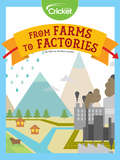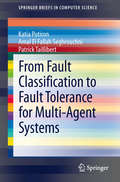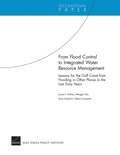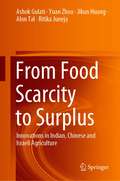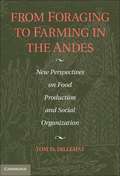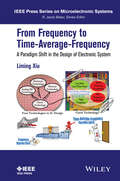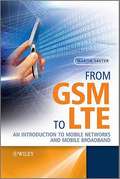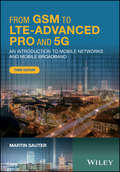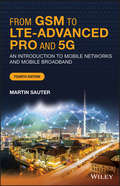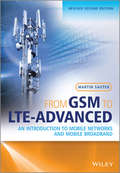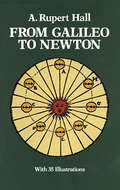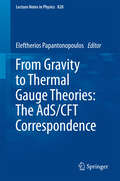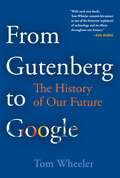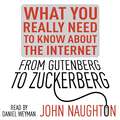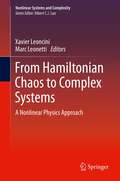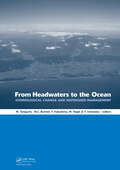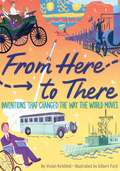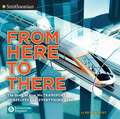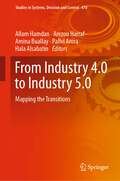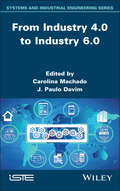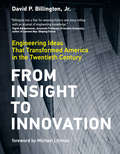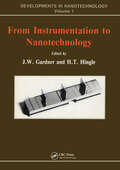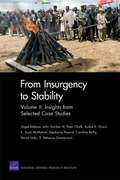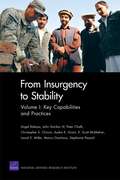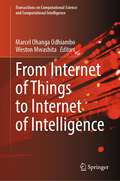- Table View
- List View
From Farms to Factories
by Marcia Amidon LustedThe industrial revolution? Was that a war? No, it was a time of inventions, progress, and modernity!
From Fault Classification to Fault Tolerance for Multi-Agent Systems
by Amal El Fallah Seghrouchni Patrick Taillibert Katia PotironFaults are a concern for Multi-Agent Systems (MAS) designers, especially if the MAS are built for industrial or military use because there must be some guarantee of dependability. Some fault classification exists for classical systems, and is used to define faults. When dependability is at stake, such fault classification may be used from the beginning of the system's conception to define fault classes and specify which types of faults are expected. Thus, one may want to use fault classification for MAS; however, From Fault Classification to Fault Tolerance for Multi-Agent Systems argues that working with autonomous and proactive agents implies a special analysis of the faults potentially occurring in the system. Moreover, the field of Fault Tolerance (FT) provides numerous methods adapted to handle different kinds of faults. Some handling methods have been studied within the MAS domain, adapting to their specificities and capabilities but increasing the large amount of FT methods. Therefore, unless being an expert in fault tolerance, it is difficult to choose, evaluate or compare fault tolerance methods, preventing a lot of developed applications from not only to being more pleasant to use but, more importantly, from at least being tolerant to common faults. From Fault Classification to Fault Tolerance for Multi-Agent Systems shows that specification phase guidelines and fault handler studies can be derived from the fault classification extension made for MAS. From this perspective, fault classification can become a unifying concept between fault tolerance methods in MAS.
From Flood Control to Integrated Water Resource Management
by Debra Knopman Sara Hajiamiri Mengjie Wu James P. KahanThe loss of life and devastation in the Gulf coast region of the United States after the hurricane season of 2005 has led to considerable debate about how to recover from the damage and mitigate damage from future incidents. This document reports the experiences of four major floods since 1948 (two in the United States, one in the Netherlands, and one in China), to draw lessons for the Gulf coast restoration effort.
From Food Scarcity to Surplus: Innovations in Indian, Chinese and Israeli Agriculture
by Alon Tal Ashok Gulati Yuan Zhou Jikun Huang Ritika JunejaThis book brings together unique experiences of India, China and Israel in overcoming economic, social, and natural resource challenges. Through its eleven chapters, the book captures the role of groundbreaking innovations in achieving unprecedented agricultural growth and stabilizing these nations. It provides a future outlook of the new challenges that will confront these countries in 2030 and beyond, related to tackling food and nutrition security, sustainable agricultural growth and adhering to improved food safety standards. This book provides useful insights for exploring technological innovations and policies that can address these future challenges and develop profitable and sustainable agriculture. This volume also highlights valuable lessons that India, China and Israel provide for the rest of the developing world where population is growing fast; natural resources are limited; and it is a challenge to produce enough food, feed and fibre for their populations. Tracing the historical past, this book is an impressive resource for academicians, policymakers, practitioners, agribusiness players, entrepreneurs in understanding the role of innovations in addressing future challenges.
From Foraging to Farming in the Andes: New Perspectives on Food Production and Social Organization
by Tom D. DillehayArcheologists have always considered the beginnings of Andean civilization from c. 13,000 to 6,000 years ago to be important in terms of the appearance of domesticated plants and animals, social differentiation, and a sedentary lifestyle, but there is more to this period than just these developments. During this period, the spread of crop production and other technologies, kinship-based labor projects, mound-building and population aggregation formed ever-changing conditions across the Andes. From Foraging to Farming in the Andes proposes a new and more complex model for understanding the transition from hunting and gathering to cultivation. It argues that such developments evolved regionally, were fluid and uneven, and were subject to reversal. This book develops these arguments from a large body of archaeological evidence, collected over 30 years in two valleys in northern Peru, and then places the valleys in the context of recent scholarship studying similar developments around the world.
From Frequency to Time-Average-Frequency
by Liming XiuWritten in a simple, easy to understand style, this book will teach PLL users how to use new clock technology in their work in order to create innovative applications. * Investigates the clock frequency concept from a different perspective--at an application level * Teaches engineers to use this new clocking technology to create innovations in chip/system level, through real examples extracted from commercial products
From GSM to LTE
by Martin SauterA new edition of Wiley's Communication Systems for the Mobile Information Society, from the same author Wireless systems such as GSM, UMTS, LTE, WiMAX, Wi-Fi and Bluetooth offer possibilities to keep people connected while on the move. In this flood of technology, From GSM to LTE: An Introduction to Mobile Networks and Mobile Broadband enables readers to examine and understand each technology, and how to utilise several different systems for the best results. This book contains not only a technical description of the different wireless systems available today, but also explains the rationale behind the different mechanisms and implementations; not only the 'how' but also the 'why' is focused on. Thus the advantages and also limitations of each technology become apparent.Offering a solid introduction to major global wireless standards and comparisons of the different wireless technologies and their applications, this new edition has been updated to provide the latest directions and activities in 3GPP standardization reaching up to Release 10, and importantly includes a new chapter on LTE. The new LTE chapter covers aspects such as Mobility Management and Power Optimization, Voice over LTE, and Air Interface and Radio Network.Provides readers with an introduction to major global wireless standards and compares the different wireless technologies and their applications The performance and capacity of each system in practice is analyzed and explained, accompanied with practical tips on how to discover the functionality of different networks Offers approximately 25% new material, which includes a major new chapter on LTE and updates to the existing material including Release 4 BICN in relation to GSM Questions at the end of each chapter and answers on the accompanying website (http://www.wirelessmoves.com) make this book ideal for self study or as course material
From GSM to LTE-Advanced Pro and 5G: An Introduction to Mobile Networks and Mobile Broadband
by Martin SauterA comparative introduction to major global wireless standards, technologies and their applications From GSM to LTE-Advanced Pro and 5G: An Introduction to Mobile Networks and Mobile Broadband, 3rd Edition provides technical descriptions of the various wireless technologies currently in use. It explains the rationales behind their differing mechanisms and implementations while exploring the advantages and limitations of each technology. This edition has been fully updated and substantially expanded to reflect the significant evolution in mobile network technology occurring over the past several years. The chapter on LTE has been extensively enhanced with new coverage of current implementations of LTE carrier aggregation, mobility management, cell reselection and handover procedures, as well as the latest developments in 5G radio and core networks in 3GPP. It now features additional information on the TD-LTE air interface, IPv6 in mobile networks, Network Function Virtualization (NFV) and Narrowband Internet of Things (NB-IOT). Voice-over-LTE (VoLTE) is now treated extensively in a separate chapter featuring coverage of the VoLTE call establishment process, dedicated bearer setup, header compression, speech codec and bandwidth negotiation, supplementary service configuration and VoLTE emergency calls. In addition, extensive coverage of Voice-over-Wifi and mission critical communication for public safety organizations over LTE has been added. The WLAN chapter now provides coverage of WPA2-Professional with certificates for authentication in large deployments, such as the global Eduroam network and the new WLAN 60 GHz air interface. Bluetooth evolution has been addressed by including a detailed description of Bluetooth Low Energy (BLE) in the chapter devoted to Bluetooth. Describes the different systems based on the standards, their practical implementation and design assumptions, and the performance and capacity of each system in practice is analyzed and explained Questions at the end of each chapter and answers on the accompanying website make this book ideal for self-study or as course material.
From GSM to LTE-Advanced Pro and 5G: An Introduction to Mobile Networks and Mobile Broadband
by Martin SauterA revised edition of the text that offers a comparative introduction to global wireless standards, technologies, and their applications The revised and updated fourth edition of From GSM to LTE-Advanced Pro and 5G: An Introduction to Mobile Networks and Mobile Broadband offers an authoritative guide to the technical descriptions of the various wireless technologies currently in use. The author—a noted expert on the topic—explains the rationale behind their differing mechanisms and implementations while exploring the advantages and limitations of each technology. The fourth edition reflects the significant changes in mobile network technology that have taken place since the third edition was published. The text offers a new chapter on 5G NR that explores its non-standalone and standalone architecture. In the Wi-Fi chapter, additional sections focus on the new WPA3 authentication protocol, the new 802.11ax air interface and protocol extensions like 802.11k and 11v for meshed networks. This important book: Presents the various systems based on the standards, their practical implementation and design assumptions, and their performance and capacity Provides an in-depth analysis of each system in practice Offers an updated edition of the most current changes to mobile network technology Includes questions at the end of each chapter and answers on the accompanying website that make this book ideal for self-study or as course material Written for students and professionals of wireless technologies, the revised fourth edition of From GSM to LTE-Advanced Pro and 5G provides an in-depth review and description of the most current mobile networks and broadband.
From GSM to LTE-Advanced: An Introduction to Mobile Networks and Mobile Broadband
by Martin SauterThis revised edition of Communication Systems from GSM to LTE: An Introduction to Mobile Networks and Mobile Broadband Second Edition (Wiley 2010) contains not only a technical description of the different wireless systems available today, but also explains the rationale behind the different mechanisms and implementations; not only the ‘how’ but also the ‘why’. In this way, the advantages and also limitations of each technology become apparent. Offering a solid introduction to major global wireless standards and comparisons of the different wireless technologies and their applications, this edition has been updated to provide the latest directions and activities in 3GPP standardization up to Release 12, and importantly includes a new chapter on Voice over LTE (VoLTE). There are new sections on Building Blocks of a Voice Centric Device, Building Blocks of a Smart Phone, Fast Dormancy, IMS and High-Speed Downlink Packet Access, and Wi-Fi-Protected Setup. Other sections have been considerably updated in places reflecting the current state of the technology. • Describes the different systems based on the standards, their practical implementation and design assumptions, and the performance and capacity of each system in practice is analyzed and explained • Questions at the end of each chapter and answers on the accompanying website make this book ideal for self-study or as course material
From Galileo to Newton
by A. Rupert HallThe near century (1630-1720) that separates the important astronomical findings of Galileo Galilei (1564-1642) and the vastly influential mathematical work of Sir Isaac Newton (1642-1727) represents a pivotal stage of transition in the history of science. As a result of the raging intellectual battle between tradition and innovation that began in the fifteenth century, science was penetrated by a new outlook that placed emphasis on experiment and observation. Galileo showed the promise of its new methods of discovery; Newton brought out their full force and effect. Galileo suffered from an attempt to censure scientific inquiry; Newton showed how science could discover the universal laws of nature. The triumph of this new outlook marked the birth of modern science.From Galileo to Newton describes those new patterns of thought that emerged during this time of great excitement and widespread controversy. It discusses the discoveries revealed by telescope and microscope in the work of Huygens and Leeuwenhoek, and the new speculations to which these gave rise; Boyle's attempts to include chemical experiments within a rational theory of matter, and those begun by Descartes to explain the workings of the body on the basis of chemical and physical principles; and the revolutionary ideas in astronomy that generated the transition from the Ptolemaic concept of the universe to the Copernican and the subsequent acceptance of the heliostatic system.Since the dawn of civilization man has tried to find logic in the mysterious and order in the chaotic. From Galileo to Newton will appeal to anyone who wants to know what modern science is all about and how it came into being. One of the foremost authorities on the history of science, Professor Hall is not only a scholar of great learning and originality, he also writes with clarity, liveliness, and a keen biographical sense.
From Gravity to Thermal Gauge Theories: The AdS/CFT Correspondence
by Eleftherios PapantonopoulosThe AdS/CFT correspondence is a powerful tool in studying strongly coupled phenomena in gauge field theories, using results from a weakly coupled gravity background studied in the realm of string theory. AdS/CFT was first successfully applied to the study of phenomena such as the quark-gluon plasma produced in heavy ions collisions. Soon it was realized that its applicability can be extended, in a more phenomenological approach, to condensed matter systems and to systems described by fluid dynamics. The set of tutorial reviews in this volume is intended as an introduction to and survey of the principle of the AdS/CFT correspondence in its field/string theoretic formulation, its applicability to holographic QCD and to heavy ions collisions, and to give a first account of processes in fluid dynamics and condensed matter physics, which can be studied with the use of this principle. Written by leading researchers in the field and cast into the form of a high-level but approachable multi-author textbook, this volume will be of benefit to all postgraduate students, and newcomers from neighboring disciplines wishing to find a comprehensive guide for their future research.
From Gutenberg To Google: The History Of Our Future
by Tom WheelerIn an era of seemingly instant change, it's easy to think that today's revolutions--in communications, business, and many areas of daily life--are unprecedented. Today's changes may be new and may be happening faster than ever before. But our ancestors at times were just as bewildered by rapid upheavals in what we now call "networks"--the physical links that bind any society together. <p><p> In this fascinating book, former FCC chairman Tom Wheeler brings to life the two great network revolutions of the past and uses them to help put in perspective the confusion, uncertainty, and even excitement most people face today. The first big network revolution was the invention of movable-type printing in the fifteenth century. This book, its millions of predecessors, and even such broad trends as the Reformation, the Renaissance, and the multiple scientific revolutions of the past 500 years would not have been possible without that one invention. The second revolution came with the invention of the telegraph early in the nineteenth century. Never before had people been able to communicate over long distances faster than a horse could travel. Along with the development of the world's first high-speed network--the railroad--the telegraph upended centuries of stability and literally redrew the map of the world. <p> Wheeler puts these past revolutions into the perspective of today, when rapid-fire changes in networking are upending the nature of work, personal privacy, education, the media, and nearly every other aspect of modern life. But he doesn't leave it there. Outlining "What's Next," he describes how artificial intelligence, virtual reality, blockchain, and the need for cybersecurity are laying the foundation for a third network revolution.
From Gutenberg to Zuckerberg: What You Really Need to Know About the Internet
by John NaughtonJohn Naughton is the Observer's â??Networker' columnist, a prominent blogger, and Vice-President of Wolfson College, Cambridge. The Times has said that his writings, "[it] draws on more than two decades of study to explain how the internet works and the challenges and opportunities it will offer to future generations," and Cory Doctrow raved that "this is the kind of primer you want to slide under your boss's door." In From Gutenberg to Zuckerberg, Naughton explores the living history of one of the most radically transformational technologies of all time. From Gutenberg to Zuckerberg is a clear-eyed history of one of the most central, and yet most taken-for-granted, features of modern life: the internet. Once a technological novelty and now the very plumbing of the Information Age, the internet is something we have learned to take largely for granted. So, how exactly has our society become so dependent upon a utility it barely understands? And what does it say about us that this is so? While explaining in highly engaging language the way the internet works and how it got to be the way it is, technologist John Naughton has distilled the noisy chatter surrounding the technology's relentless evolution into nine essential areas of understanding. In doing so, he affords readers deeper insight into the information economy and supplies the requisite knowledge to make better use of the technologies and networks around us, highlighting some of their fascinating and far-reaching implications along the way.(P)2013 Quercus Editions Ltd
From Hamiltonian Chaos to Complex Systems: A Nonlinear Physics Approach
by Xavier Leoncini Marc LeonettiFrom Hamiltonian Chaos to Complex Systems: A Nonlinear Physics Approach collects contributions on recent developments in non-linear dynamics and statistical physics with an emphasis on complex systems. This book provides a wide range of state-of-the-art research in these fields. The unifying aspect of this book is demonstration of how similar tools coming from dynamical systems, nonlinear physics, and statistical dynamics can lead to a large panorama of research in various fields of physics and beyond, most notably with the perspective of application in complex systems.
From Headwaters to the Ocean: Hydrological Change and Water Management - Hydrochange 2008, 1-3 October 2008, Kyoto, Japan
by Makoto Taniguchi Martin Haigh William C. Burnett Yoshihiro Fukushima Yu UmezawaThe vulnerability of water resources due to climate change and human activities is globally increasing. The phenomenon of hydrological change is complicated because of the combinations and interactions between natural climate fluctuation, global warming and human activities including changes in land utilization. The impact areas of hydrological cha
From Here to There: Inventions That Changed the Way the World Moves
by Gilbert Ford Vivian KirkfieldCelebrating the invention of vehicles, this collective biography tells the inspiring stories of the visionaries who changed the way we move across air, water, and land. Perfect for fans of Mistakes that Worked and Girls Think of Everything.In a time when people believed flying was impossible, Joseph and Etienne Montgolfier proved that the sky wasn&’t the limit. When most thought horseback was the only way to race, Bertha and Karl Benz fired up their engines. From the invention of the bicycle and the passenger steam locomotive, to the first liquid-fuel propelled rocket and industrial robot, inventors across the world have redefined travel. Filled with informative sidebars and colorful illustrations, this collective biography tells the story of the experiments, failures, and successes of visionaries who changed the way the world moves.
From Here to There: The Story of How We Transport Ourselves and Everything Else
by Hp NewquistThis lively history of transportation follows our fascinating route from primitive technology like sandals to driverless cars and beyond! Since humans first stood upright, we've been on the move. Need food? Water? Land? A place to live? Survival depends upon motion. For thousands of years, people have devised ways to move faster, farther, and more comfortably. Their inventions—shoes, skis, the rudder, the wheel, engines, rockets—have had an enormous impact on how and where human beings live and thrive. When human beings get a move on, change happens:- The wheel, probably first used in the Middle East around 6,000 years ago, meant building and trading supplies could be moved more easily—whole civilizations rolled out.- The Vikings sailed far and wide because they used a keel on their longships. - Horse-and-carriage gridlock gave rise to subways. - The bicycle changed the world for women in terms of freedom and fashion.- Drones and driverless cars are the future . . . coming sooner than we think. Award-winning author HP Newquist explores the transportation inventions and technologies that have transformed the way we experience the world around us. It’s a fascinating journey!
From Industry 4.0 to Industry 5.0: Mapping the Transitions (Studies in Systems, Decision and Control #470)
by Allam Hamdan Arezou Harraf Pallvi Arora Amina Buallay Hala AlsabatinThis book aims at bringing together global researchers to generate thought on how this transition from Industry 4.0 to Industry 5.0 could make a difference to the globe for larger good. The collaboration and interaction between man and machine has given rise to Industry 5.0. With the prime objective of Industry 5.0 to create a benefit for the human beings while tapping on to the advantage of Industry 4.0, in no case, does it replace what has already been achieved. In fact, it brings to light what can be done in order to make life better. While Industry 4.0 offered extraordinary technological advancement, Industry 5.0 reasons out that technology alone is not sufficient to answer everything or provide a solution, but it is an amalgamation of both machine and human interaction to create that difference. In fact, with the impact of widespread digitalization that has led to dehumanization of the industrial makeup, the interest of global researchers has increased toward mapping how the human creativity and brainpower can be reconciled with the intelligent systems that can enhance process efficiency.Industry 5.0 has touched upon some of those key domains which are of much concern and debate globally including resilience (both business and cyber), environment and sustainability, diversity and inclusion, values and ethics, vision and purpose, circular economy, understanding the human–machine collaboration and the ‘human-touch’ in the production process.This transition that has taken place in moving from Industry 4.0 to Industry 5.0 has essentially created a need to pay cognizance to the role of ‘human’ in the process which creates an enhanced focus toward the right kind of skills and competencies, identification of training and developmental needs, talent acquisition and management, safety and wellbeing, future of work as well as hybrid working models.Undeniably, the pace with which Industry 4.0 has been accelerating has bypassed the first three industrial revolutions, which is definitely a consequence of the fast introduction of new and cutting-edge technologies. While organizations are already in analyzing the context, mapping this transition and the flow of activities from Industry 4.0 to 5.0 is gaining attention as Industry 4.0 lacked personalization and customization. This co-existence of man and machine creates a pathway for newer prospects and opportunities to emerge and expand possibilities of personalization with the empowerment of ‘human’ in the production process.This lays the foundation for this book. This book adopts a forward-looking approach by bringing in research and contributions that facilitate in mapping the consereasons, consequences and solutions for ‘man+machine’ across industries. This book serves as a guide not just to academia but also to the industry to adopt suitable strategies that offer insights into global best practices as well as the innovations in the domain.
From Industry 4.0 to Industry 6.0 (ISTE Invoiced)
by J. Paulo Davim Carolina MachadoIndustry 4.0 marked a revolution in industrial processes, introducing connectivity and digitalization as key elements to improve efficiency and productivity. However, technological evolution moves ever forward, and now the prospect of Industry 6.0 has emerged, a new era that promises to radically transform the way we view industrial production. Indeed, Industry 6.0 looks to go further, introducing revolutionary concepts that will redefine how we view industrial production. Conscious of this reality, From Industry 4.0 to Industry 6.0 highlights the importance and impact this technological evolution will have on the way today's organizations develop into proactive, innovative and competitive agents. Organized into eight chapters, From Industry 4.0 to Industry 6.0 can be used by various potential stakeholders, not only academics and researchers, but managers, engineers, practitioners and other professionals who develop their professional activity in different areas of management and engineering.
From Insight to Innovation: Engineering Ideas That Transformed America in the Twentieth Century
by David P. BillingtonThe engineering ideas behind key twentieth-century technical innovations, from great dams and highways to the jet engine, the transistor, the microchip, and the computer.Technology is essential to modern life, yet few of us are technology-literate enough to know much about the engineering that underpins it. In this book, David P. Billington, Jr., offers accessible accounts of the key twentieth-century engineering innovations that brought us into the twenty-first century. Billington examines a series of engineering advances--from Hoover Dam and jet engines to the transistor, the microchip, the computer, and the internet--and explains how they came about and how they work.
From Instrumentation to Nanotechnology
by J.W. GardnerAddressed to physical and chemical scientists and engineers, this book provides information on the design, manufacture, and assessment of components with critical dimensions or critical tolerances in the 0.1-100 nanometer range. Such tiny parts are now used in automobile engines, cassette players, and other common products. The 16 lectures presented are from an advanced vacation school on instrumentation and nanotechnology in Warwick, England, September 1990. Among the topics are signal processing, ultrasonic sensors, and nanoactuators for controlled displacements..
From Insurgency to Stability: Insights from Selected Case Studies
by Peter Chalk Angel Rabasa John Gordon Audra K. Grant K. Scott McmahonThis book examines six case studies of insurgencies from around the world to determine the key factors necessary for a successful transition from counterinsurgency to a more stable situation. The authors review the causes of each insurgency and the key players involved, and examine what the government did right--or wrong--to bring the insurgency to an end and to transition to greater stability.
From Insurgency to Stability: Key Capabilities and Practices
by Peter Chalk Angel Rabasa Christopher S. Chivvis John Gordon Audra K. GrantThis book identifies the procedures and capabilities that the U.S. Department of Defense, other agencies of the U.S. government, U.S. allies and partners, and international organizations require in order to support the transition from counterinsurgency, when the military takes primary responsibility for security and economic operations, to stability and reconstruction, when police and civilian government agencies take the lead.
From Internet of Things to Internet of Intelligence (Transactions on Computational Science and Computational Intelligence)
by Marcel Ohanga Odhiambo Weston MwashitaThe book focuses on the open challenges associated with the convergence of the Internet of Things and Artificial Intelligence, as accommodated in 6G architecture. The authors discuss how in many fields, such as Natural Language Processing (NLP), interactive computer games, robotics, and multiuser virtual environments, this convergence is likely to have enormously benefits, from artificial intelligence mimicking human intelligence, attempting to simulate human intelligence, and producing a new intelligent machine capable of processing information with human consciousness, behaviour, and thinking integrated with appropriate algorithms. The book provides users with the fundamentals of IoT architecture, AI technology, and the architecture of AI and IoT converged networks. Furthermore, to provide hands-on experience with the technology, some proposed systems are discussed, along with their applications in various sectors such as healthcare, transportation, smart homes, production, manufacturing, renewable energy and agriculture. The book will discuss new technological advances, current research trends, and industry requirements. Discussed open challenges in the field will motivate researchers and stakeholders in industry to provide solutions, with some presented in the book to help spark ideas.
